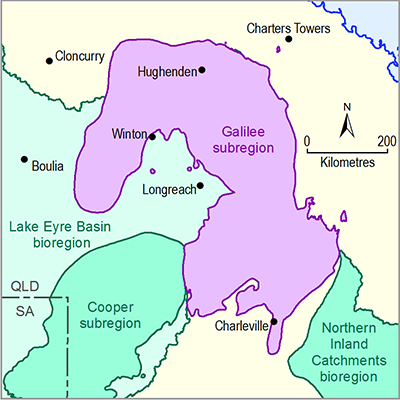The prediction results show that the additional coal resource development in the Galilee subregion can have considerable impacts on all of the hydrological response variables. The comparison among the 61 model nodes shows that the relative hydrological changes are larger for the model nodes where the maximum additional coal resource development percentage is larger. For instance, the model nodes with the three largest additional coal resource development footprints are nodes 3, 15 and 2, where the maximum percentage increases in footprint are 24%, 19% and 17%, respectively. The resulting median pmax values for the three high-streamflow flux-based variables (AF, P99 and IQR) are around –21% for node 3, –19% for node 15, and –16% for node 2. In general, the median impact on these variables is highly correlated with and commensurate with the maximum proportion of the catchment that is included in the additional coal resource development footprint.
For each of the flux-based hydrological response variables, the biggest impacts (in terms of pmax) are predicted to occur at nodes 3 and 15. Node 3 is located downstream of the additional coal resource development expansions to the South Galilee Coal Project, while node 15 is downstream of the China Stone Coal Project and Carmichael Coal Mine Project. Both nodes 3 and 15 have relatively small catchment areas. While there are bigger predicted changes in amax at model nodes further downstream, the proportional impacts of these changes are diluted by relatively unaffected inflows.
In contrast, the biggest impacts (in terms of amax) on the low-streamflow hydrological response variables are predicted to occur further downstream at node 7 (in Sandy Creek) for LFS and at nodes 34 and 61 (in the Belyando River) for ZFD, LFD and LLFS. Node 7 is wholly or partly downstream of all four mine developments along Sandy Creek (Kevin’s Corner, Alpha, China First and South Galilee coal projects). In addition to being downstream of these same developments, nodes 34 and 61 are either partly downstream of, or affected by groundwater drawdown associated with, the proposed Carmichael Coal Mine Project.
The prediction that the biggest impacts occur downstream of multiple mine developments highlights the cumulative nature of potential hydrological impacts, particularly on low-streamflow characteristics. These impacts, however, are not quite as large further down the Belyando River, despite the potential for further additional coal resource development impacts from the proposed Carmichael Coal Mine Project and the China Stone and Hyde Park coal projects. This suggests that, with augmentation from unaffected tributaries such as the upper Carmichael River, Tomahawk Creek and Mistake Creek, low flows are more stable in the reaches below node 61.
The additional coal resource development impacts on the low-streamflow hydrological response variables (ZFD, LFD, LFS and LLFS) appear to be less substantial than those on the high-streamflow hydrological response variables (AF, P99 and FD) for model nodes immediately downstream of mine developments, but more substantial for nodes further downstream of the developments and where impacts from multiple developments accrue. This is demonstrated by comparison of the two frequency-based variables that are most directly comparable – FD and LFD. In model nodes immediately downstream of the developments, the impact (in absolute terms) on FD is greater than on LFD. For example, at node 3, FD decreases by 24 days, while LFD increases by only 15 days. On the other hand, further downstream at node 61, where the impacts of several coal mines accumulate, FD decreases by 3 days, while LFD increases by 200 days.
The magnitude of some of the changes in ZFD and LFD are particularly noteworthy, especially as these variables are likely to be particularly important in an ecological context. Median maximum increases of 200 days per year in LFD in the middle reaches of the Belyando River represent more than half the year. While this change reports the median of the greatest predicted annual change among the 347 replicates, and is therefore not expected to occur every year, it nonetheless represents a substantial reduction in flow characteristics.
The change in hydrology predicted due to the additional coal resource development is largest in absolute terms at the downstream end of the Belyando River system, where a median maximum decrease of about 28 GL in AF is predicted, which corresponds to a change of less than 1%. The relative decrease is largest in the model nodes immediately downstream of mines, with median decreases of up to 20% downstream of the South Galilee Coal Project and the proposed Carmichael Coal Mine Project.
For high-streamflow hydrological response variables, the tmax at model nodes with noticeable changes occurs approximately when the maximum additional coal resource development occurs. For most such model nodes, this is 2040. This indicates that the instantaneous streamflow reduction caused by the additional mine footprint dominates amax and pmax in these hydrological response variables and suggests that the changes from the cumulative impact on baseflow over time caused by drawdown of the watertable are negligible.
For low-streamflow hydrological response variables, the tmax at model nodes with noticeable changes does not occur consistently with the time when the maximum additional coal resource development footprint occurs. At the most heavily impacted model nodes (those in tributary 2), the predicted median tmax values tend to be a little later for three of the low-streamflow hydrological response variables (ZFD, LFD and LLFS), with the greatest impacts typically being predicted to be after 2060. This is much later than the times of maximum additional coal resource development footprint (Table 4). This indicates that the causes of the impacts on the low-streamflow variables are controlled by a combination of the instantaneous impact from the additional mine footprints and the cumulative impact on baseflow over time caused by drawdown of the watertable.
Further discussion on the implications of changes to surface water hydrological response variables and their potential for impact to surface water systems are outlined in Section 3.3 of companion product 3-4 for the Galilee subregion (Lewis et al., 2018).

